Florida’s Asters

Asteraceae is an enormous family of flowering plants. Daisies, sunflowers, zinnias, marigolds, and more are all grouped together in this category.
Most aster species can be recognized by their composite flowers. Composite flowers are made up of hundreds of tiny flowers, with disk flowers at the center and ray flowers around the edges.
According to the Atlas of Florida Plants there are 440 asters in Florida, 331 of which are native species. In fact, 41 species are endemic, found only in Florida. Of course, covering hundreds of aster species would turn this article into a book. Instead, here are a dozen of our favorites.
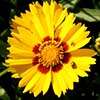
Coreopsis — This native aster is Florida’s state wildflower. Commonly known as tickseed, coreopsis comes in many species and varieties. Most are daisy-like with a ring of yellow petals surrounding a brown or yellow center. They typically bloom in spring and summer. You can find seeds and plants at your local garden center or from another seed source. Sow your seeds anytime from October through January. Choose a sunny spot and plant the seeds about one-eighth of an inch deep.
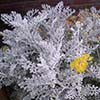
Dusty miller — A popular aster known for something other than its floral display is dusty miller (Senecio cineraria). Its silvery, fern-like foliage makes dusty miller a perfect background for other plants. It looks especially nice when contrasted with colorful, flowering annuals. Dusty miller can be planted from October through May in Florida. Water to help it get established, and then only as needed. While it does produce attractive yellow flowers, many gardeners remove these to encourage leaf growth.
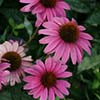
Echinacea — Purple coneflower (Echinacea purpurea) is a beautiful perennial that, despite the name, comes in a variety of colors. The native purple varieties attract and feed butterflies. Cultivars like ‘Hot Papaya’, ‘Mac ‘n’ Cheese’, or ‘Raspberry Truffle’ boast bolder colors and flower shapes. Echinacea’s daisy-like flowers bloom throughout spring and summer on tall flower stalks. Not all forms of purple coneflower perform well in every part of Florida. Enriched, well-drained soil can help them last longer.

Elliot’s aster — Symphyotrichum elliottii, or Elliot’s aster, is another native perennial Florida aster. Its sprawling shape quickly fills gaps in pollinator gardens and is very attractive to bees. Its light purple, delicate blooms emerge in late summer and early fall. It grows happily in USDA Hardiness Zones 8B – 10B and tolerates a range of soils. Elliot’s aster looks its best in full sun and doesn’t tolerate salt. Make sure you have plenty of space, though; Elliot’s aster often reaches heights of 3 to 4 feet.
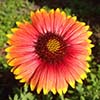
Gaillardia — A recent discovery suggests that blanket flower (Gaillardia pulchella) is not actually native to Florida (Weakley 2020). It’s native to the southwestern United States, and was likely introduced to the east sometime in the last few centuries. Still, blanket flower is an excellent nectar and pollen resource. It also remains on our list of Florida-Friendly plants. But for gardeners who prefer native wildflowers, consider lanceleaf blanketflower (Gaillardia aestivalis). This wildflower has much of the charm of G. pulchella and is native to North and Central Florida.

Lettuces — Did you know that lettuces are members of the aster family, too? Winter is the perfect time to grow lettuce in Florida. Although we try to avoid allowing it to flower, these species do produce compound, disk-like flowers. Lettuce comes in four major types: crisphead, butterhead, leaf, and romaine. All four can be grown in Florida, but leaf lettuce often works best. It’s more suited to our mild climate and can be harvested throughout the season.
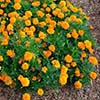
Marigold — There’s a reason you see marigolds in so many Florida gardens. They’re easy to grow, bloom reliably all summer, and have few insect and disease problems. Available in a range of yellows and oranges, these annuals are often used for color massing, edging, borders, cut flowers, and container plantings. Marigolds (Tagetes spp.) are known for their ability to suppress some species of plant-parasitic nematodes. Unfortunately, they’re unlikely to rid your garden of nematodes entirely or protect nearby plants (see our article, “Garden Myths, Volume One”).
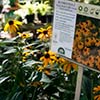
Rudbeckia — Black-eyed Susan (Rudbeckia hirta) and the less common brown-eyed Susan (R. triloba) are both native to Florida. Cutleaf coneflower (R. laciniata) is another Rudebeckia of the eastern U.S., though it is even less common. Whichever you choose, these coneflowers are perfect choices for a pollinator garden. Plant seeds directly in the garden or buy small plants. Choose a sunny, well-drained location in the spring. The flowers will develop a few months after the seed is planted, and should persist throughout the summer while other plants wilt.

Stokes’ aster — It’s no secret that the Master Gardener Volunteer program loves Stokes’ aster. Stokesia laevis flowers are normally blue-lilac. Cultivars are also available in deep blue, purple, pink, white, and even yellow. Flowers can grow to be as large as four inches across and begin blooming in spring. This species performs best in zones 8 through 9A. It prefers partially sunny locations with well-drained, acidic soil. You can learn more by reading our Stokes’ Aster article, also on Gardening Solutions.
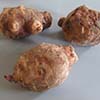
Sunchoke (Jerusalem artichoke) — Another aster more famous for its edible portions than its flowers is sunchoke. Also called Jerusalem artichoke, Helianthus tuberosus is a mild-tasting root vegetable that can be grown throughout the state. Plant sunchoke in early spring, either as whole tubers or as seed pieces. The plants can reach six to ten feet tall and are ready to harvest after about four months. Smaller tubers in a salad add a flavor and crunch similar to water chestnuts. Larger tubers can be cooked and eaten like potatoes.
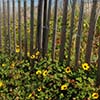
Sunflowers — Sunflowers just seem to belong in the Sunshine State. In addition to the famous, towering sunflower varieties there are several native Helianthus species, too. Swamp sunflower (Helianthus angustifolius) is a medium-tall perennial that blooms in fall. The two- to three-inch flowers sport rich yellow petals and brown or burgundy centers. Even shorter is the beach sunflower (H. debilis), another Florida native perennial. This butterfly-attracting groundcover is perfect for hot, dry sites, including coastal areas. Sunflowers will tolerate many different soil types and do best in sunny locations.
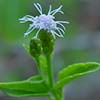
Your local asters — Not forgetting the southern-most tip of Florida, there are two asters found only in South Florida and the Keys: Cape Sable thoroughwort (Chromolaena frustrata) and small-leaf squarestem (Melanthera parvifolia). Both are endangered and so rare we had a very hard time finding photographs of them. Wherever you live in Florida, we would encourage you to include a native aster in your pollinator garden. The wider your plant selection, the more varied your pollinator visitors will be! But remember, never remove endangered species from the wild. Instead, visit a native plant nursery. You can also give us a call at your county Extension office to ask about other local sources. (Photograph of C. frustrata by Keith Aster, used with express permission.)
For more on asters, including species we didn’t cover in this article, contact your local Extension office.
